555 Edgecombe
Ronald K. Alexander
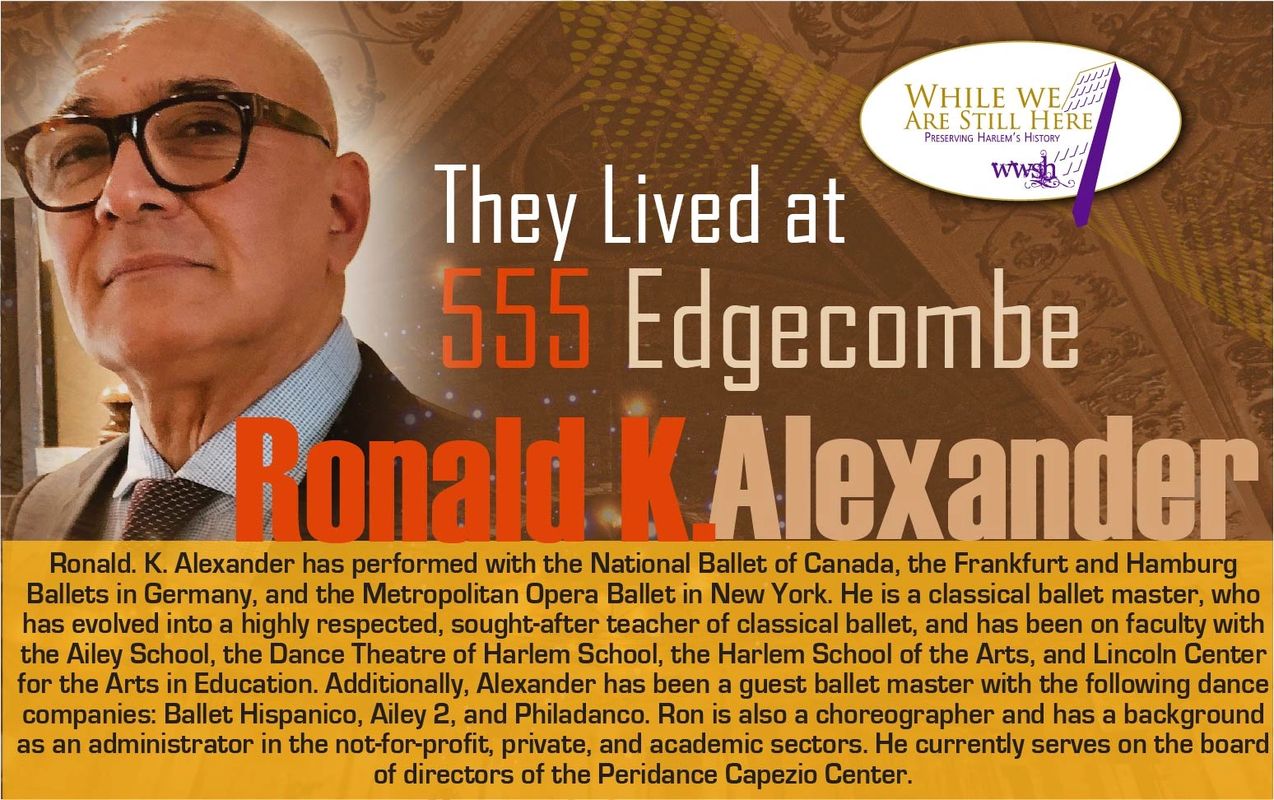
An Interview with Ronald K. Alexander
Alexander’s mastery and depth of knowledge regarding classical ballet and other dance forms have transformed him into a highly sought-after dance educator. He is also a seasoned arts administrator and consultant, as well as an activist and choreographer.
In addition to the National Ballet of Canada, Alexander, a Washington, D.C. native, has performed on international stages with the Iranian National Ballet, the Frankfurt and Hamburg Dance companies, and the Metropolitan Opera Ballet.
He has choreographed for numerous schools, colleges, and dance companies, including the Clark Center for the Performing Arts, the Ailey School, the Harlem School of the Arts, Boys and Girls Harbor Conservancy, Alpha-Omega Theatrical Dance Company, and the Nanette Bearden Dance Company. His vast teaching experiences includes his tenures at the Harlem School of the Arts, Marymount and Adelphi University Dance Departments, Clark Center for the Performing Arts, the Restoration Arts Youth Arts Academy, Ailey, and others.
Alexander has an MFA in Dance, from the Tisch School of the Arts, New York University. He was the subject of Five Teachers, Five Venues, an article in Dance Magazine. He is currently on faculty at the following: The Ailey School, Stella Adler School of Acting, and the Black Arts Institute. He is on the board of the New York City Arts in Education Roundtable and a member of the New York Dance and Performance Award, the Bessies.
William “Count” Basie

Basie Boogie
King Joe
For decades, Basie led his musicians across the nation and the world to play for millions of adoring fans. Brass and rhythm section swinging hard and funky with those boogie-woogie piano figures and understated fills. That was the Count Basie Band’s signature and still is. Basie’s approach influenced swing, and his contributions to the musical lexicon eventually resulted in his becoming the first African American to receive a Grammy. Singers who collaborated with Basie represent a who’s who of vocalists, and include Billie Holiday, Jimmy Rushing a.k.a. Mr. 5 by 5, Joe Williams, Ella Fitzgerald, Sarah Vaughn, Frank Sinatra, Carmen Bradford, and her mother, Melba Joyce.
There was another outstanding singer, who sang with Basie. Paul Robeson on “King Joe” is part of an exemplary trinity: This lyrics for this gem of a song were written by acclaimed novelist Richard Wright, with a stomp blues, written by Basie, about world heavyweight champion, Joe Louis.
Basie band members included singular instrumentalists, such as Lester Young, Joe Jones, Harry “Sweets” Edison, Buck Clayton, Frank Foster, and Clark Terry. One of the Basie Band’s signature tunes, “April In Paris,” has his wonderful instruction to his band, “let’s try it one more once.” Basie was also a close friend and confidante of Lena Horne, whom he convinced to stay in Hollywood to represent a positive image of Black womanhood.
Basie was the first African American to win a GRAMMY. His neighbor in spirit and place, Cassandra Wilson, another GRAMMY winner years hence, was also a resident of 555 Edgecombe Avenue.
One of the Basie organization’s most well-known songs is “April In Paris.” It’s a testament to the arranging chops of Wild Bill Davis, who transformed Yip Harburg and Vernon Duke’s melodious composition into a tour de force that the band still performs today. Basie’s legacy continues, led by musical director Scotty Barnhart, featuring vocalist Carmen Bradford.
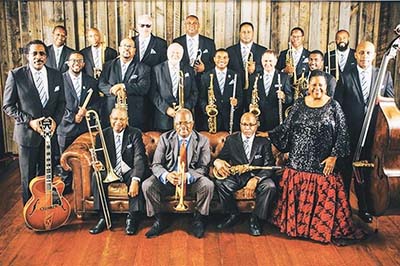
Jane Bolin

Jane Bolin was the first African American woman in the United States to be appointed to the bench. This distinguished jurist served in family court for forty years. Because of the retirement-age requirement of 70, she left the bench and served on the New York State Board of Regents.
Bolin knew early on that she would pursue a career in law, inspired by her father’s profession, but even he, initially, did not support her decision to study law. Her father, Gaius Bolin, was, also, the founder of the Poughkeepsie chapter of the NAACP.
She was a top student at Wellesley—a Wellesley Scholar—yet, an advisor there tried to discourage her from applying to Yale Law School due to her race and gender, but she became the first African American woman to graduate from there. She married fellow attorney, Ralph E. Mizelle. They opened a law practice together, Mizelle and Bolin.
As a family court judge, she adjudicated cases that included domestic violence, paternity suits, and crimes that minors committed. Also, she chose not to wear judicial robes in order to make children feel more comfortable.
Her humanitarian nature was apparent. She strove to be a beacon for social justice. In an interview with her hometown newspaper, the Poughkeepsie New Yorker, she called out segregation there, stating that “Poughkeepsie is fascist to the extent of deluding itself that there is superiority among human beings by reasons solely of color, race or religion.” In regards to women’s rights, she proclaimed, “We have to fight every inch of the way and in the face of sometimes insufferable humiliations.”
The video highlights Jane Bolin’s father, Gaius Bolin, and includes commentary about her by her family members.
Bessie Buchanan
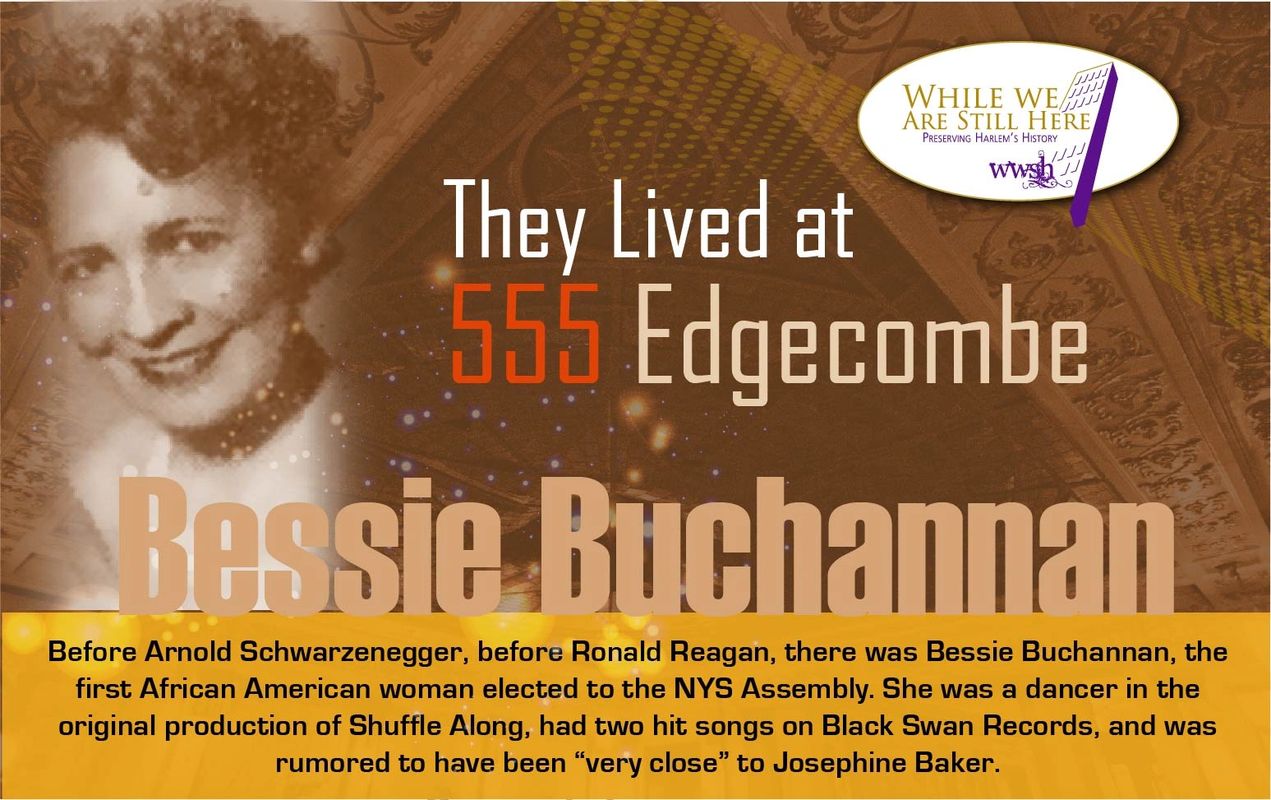
Born March 7, 1902, to Virginian parents who had recently migrated north to New York, Bessie Allison Buchanan came of age during the Harlem Renaissance. She was raised in the city’s theatrical district, emerging from her youth fully perceptive of the new opportunities arising for young Black Americans.
Buchanan first graced the public eye as a performer, with appearances in the 1925 edition of Plantation Revue and in the integrated cast of Lucky (1927) and the original Shuffle Along (1921)¬–the first successful musical comedy with an all African American cast. She was highly revered and listed among performers like Josephine Baker, her dear friend, whom, in the 1950s organized a protest against the Stork Club after an incident of racial misconduct.
In her performance career, Buchanan performed with the Show Boat road company, recorded for Black Swan Records, and danced in the chorus line of the famed Cotton Club, all while actively working in the Harlem Woman’s Civic Club. Having become one of Harlem’s social elite, Bessie married prominent Harlem businessman Charles Buchanan in 1929 and retired from her performing career.
Buchanan was nominated by the New York City Democratic Party for State Assembly in 1954, where she prevailed victoriously and became the first Black woman to the State Assembly. She served four terms in office. Later in her career, after a political shift of party support, Buchanan endorsed Republicans Governor Rockefeller and Senator Jacob Javits.
For five years, she served on the New York State Commission of Human Rights. After leaving public office, but never the public eye, Bessie Buchanan suffered a short illness and passed away in 1980 at the age of 78.
Leroy Burgess

Leroy Burgess Discussing Some Of His Vast Musical History
Leroy Burgess may not be a household name, but there’s a good chance that he had something to do with your favorite disco tune or house music jam. As writer, producer, arranger, vocalist,
Burgess’s special touch can be felt on hits like “Mainline,” “Let’s Do It,” “Moment of My Life,” and going way, way back, “You and I” and many, many more. Burgess, a Harlem native, is steeped in the traditions of various manifestations of Black Music, from jazz to gospel, and received part of his musical education at the City College of New York with the likes of Herbie Jones, a colleague of Duke Ellington and Billy Strayhorn.
Drs. Kenneth/Mamie Clark

Dr. Kenneth Bancroft Clark and Dr. Mamie Phipps Clark, the infamous married African American psychologist team responsible for “the doll test” that held great influence in the US Supreme Court Case Brown vs. Board of Education, were a driving force for racial justice through science. Together they founded the Harlem Youth Opportunities Unlimited and the Northside Center of Child Development.
They were expert witnesses in two major supreme court cases on the effects of negative racial psychology on children.
Mamie Clark, born Mamie Phipps in Hot Springs, Arkansas, was a child of immigrants from the British West Indies. She attended Howard University as a physics and mathematics major, but felt the need early in her college career to change majors due to the lack of support by the institution as a woman in the field.
Phipps met the man that would eventually be her husband and research partner, Kenneth Clark in school. Clark began his journey at Howard University as a political science major, but after working with mentor Francis Cecil Sumner, the first African American to receive a doctorate in psychology, he returned to school to receive a doctorate in psychology. Clark, himself a student of psychology, had convinced Mamie to change her major to the same field of study, and from that point on the pair became unstoppable.
After completing her undergraduate degree, Mamie and Kenneth were married and took residence in Harlem, where Kenneth had grown up with his family after immigrating from the Panama Canal Zone. The Clarks continued their education in psychology at Columbia University in the 1940s, where Mamie Phipps Clark became one of the first African American women to earn a Ph.D. in psychology from Columbia University, and the second at Columbia to receive a doctorate in psychology – her husband Kenneth being the first.
As a Black woman in psychology, it was difficult for Mamie to enter the field. Therefore her first job after graduation was working in a law office. She later worked for the American Public Health Association, and moved on to work at the United States Armed Forces Institute.
After a challenging start in professional psychology, Mamie followed her passion for working with children, and began working to improve social services for troubled youth in Harlem, She did psychological testing at the Riverdale Children's Association. She and her husband eventually opened their own children’s psychological centers in Harlem.
Kenneth Clark quickly landed a job at the City College of New York. He became the first fully tenured African American professor at the school. He later started a psychology department at Hampton Institute in 1942, became the first African American to be appointed to the New York State Board of Regents (1966), and became the first African American to be president of the American Psychological Association.
Tulani Kinard
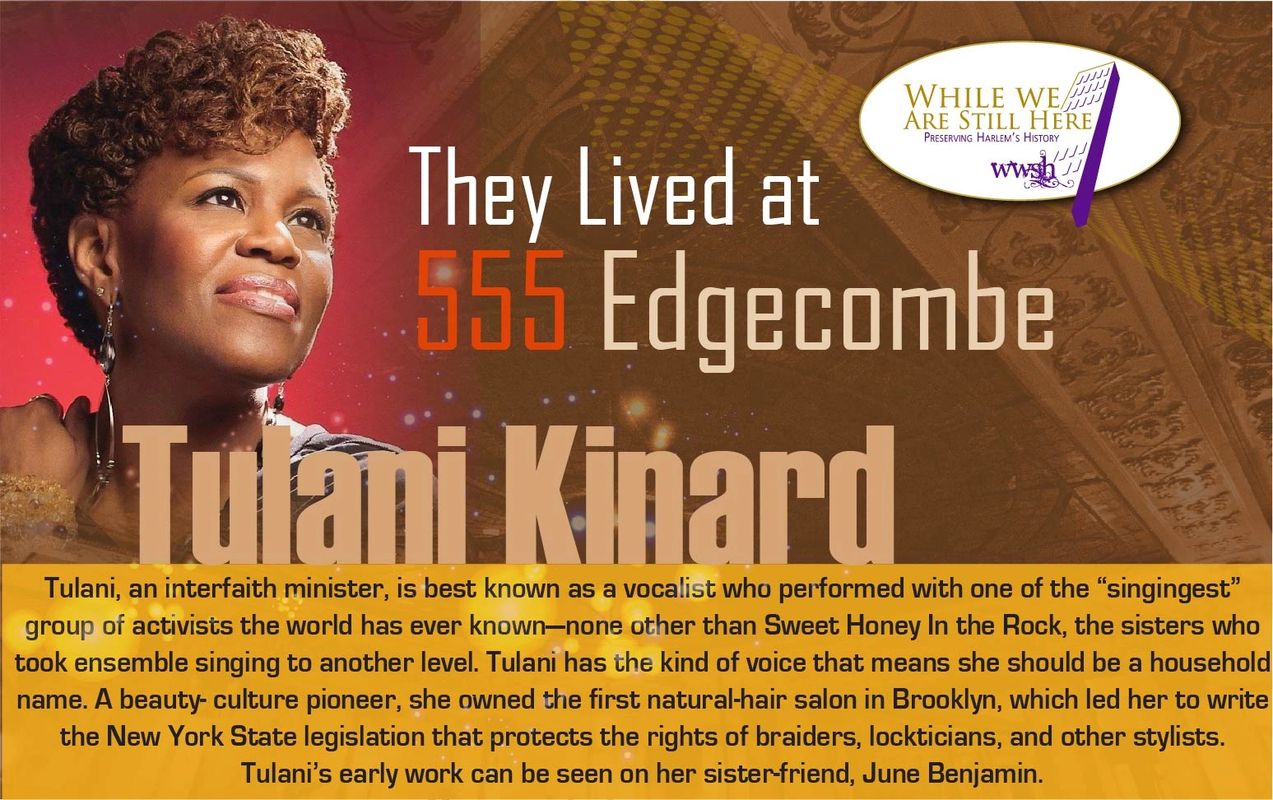
Tulani Kinard holds many titles, but she is best known as an ordained interfaith minister, vocalist, and author. Kinard in her role as an interfaith minister speaks motivation, growth, and empowerment into her community and has become known to captivate an audience with her words of wisdom. Like her spiritual leadership, Kinard’s poetry and music tell fierce stories of love, peace, transformation, activism, and enlightenment. Her music takes the power of words and interlocks them with strong and smooth tones with intent to change lives.
Kinard is best known in her musical career as a former member of Sweet Honey in the Rock— three-time Grammy Award nominated a cappella ensemble of Black women who express their history through song, dance, and sign. As an author, Tulani Kinard broke out with her beauty-culture how-to book, No Lye! The African American Woman’s Guide to Natural Hair Care.
As a natural beauty pioneer, and owner of the first natural Black hair salon in Brooklyn, NY, Kinard is dedicated to the growth of coils, curls, and locks, as well as the growth for the people that have them. Her commitment to ensuring the success of the natural hair community led her to write legislation to protect the rights of hair braiders, lockticians, and other stylists.
Joe Louis

Joseph Louis Barrow, born May 13, 1914 outside of Lafayette, Alabama, emerged in the 1930s as an African American boxing legend with fifty wins in fifty-four matches, and forty-three wins by knockout. He maintained the title of championship winner for close to twelve years.
Louis, nicknamed the “Brown Bomber,” began boxing after moving to Detroit with his family, and paid for boxing lessons at the Brewster Recreation Center with money that his mother gave him to pay for violin lessons.
Louis, hard-working and determined, trained vigorously until he won Detroit’s Golden Gloves light-heavyweight title and the national Amateur Athletic Union championship. He gained global fame as heavyweight champion on June 22, 1937 in his fight against James J. Braddock.
Outside of the ring, Louis was a generous victor and donated a portion of his money to military relief funds, as well as enlisted in the U.S. Army demonstrating his support. Louis formally retired in 1949 but returned to the ring shortly after to combat financial struggles.
Louis underwent heart surgery in 1977, and four years later died of cardiac arrest. He was, posthumously, awarded a Congressional Gold Medal in 1982.
Rose Morgan

By the time she opened a flagship salon, in Harlem, in 1955, Rose Morgan and her House of Beauty were household names across Black America—not to mention the extra notoriety she attained after she wed boxer, Joe Louis.
Morgan was an entrepreneur, who parlayed her skills in beauty culture into a thriving empire. Branching out, she opened a charm school and became a manufacturer of hair products.
The Rose Meta Morgan House of Beauty employed and trained nearly 3,000 people. When she opened in her newly purchased building,10,000 people were in attendance, including the mayor of New York City. Morgan was on the founding board of directors of Freedom National Bank.
Paul Robeson

Paul Robeson on Colonialism and African Pride
Paul Robeson: The First Black Star
Paul Robeson was so influential that, with his singing, he was able to stop the fighting, momentarily, on the battlefield during the Spanish Civil War. Because of his outsized talent and extraordinary good looks, Robeson became an internationally regarded artist and appeared in films such as Oscar Micheaux’s Body and Soul and Eugene O’Neill’s The Emperor Jones.
He and friend and colleague, Count Basie, recorded “King Joe” (with lyrics by Richard Wright) in 1941 to pay homage to another 555 resident, Joe Louis. Robeson, along with many of his neighbors and comrades, paid the cost for their outspoken political activism that called for the equality of Black Americans. Along with W.E.B. Du Bois and attorney, William Patterson, Robeson was persecuted by the American government and vilified by the McCarthy witch hunts of the mid twentieth century.
Gil Scott-Heron
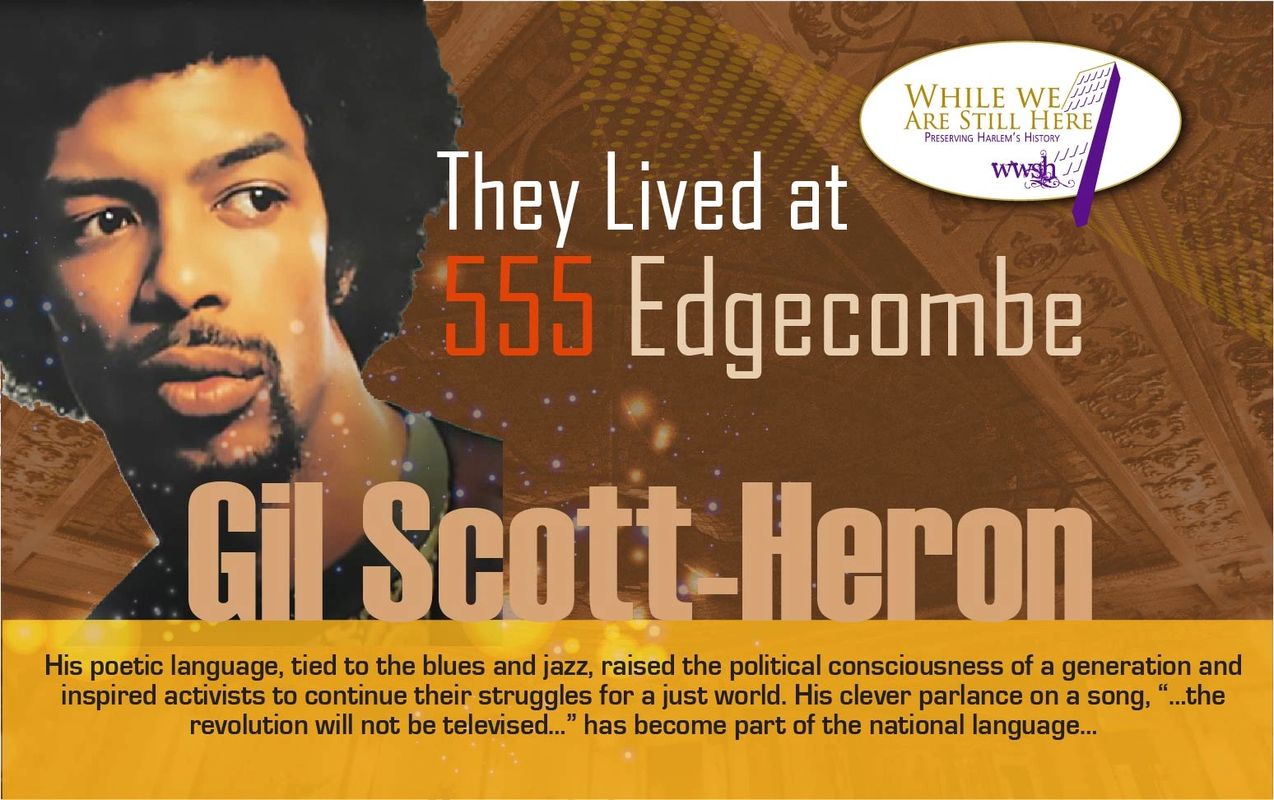
Gil Scott-Heron Pieces Of A Man
His debut album, “Pieces of a Man,” showcased his literary gifts. On the title song, penned by him and Brian Jackson, he sang—
Jagged jigsaw pieces
Tossed about the room
I saw my grandma sweepin'
With her old straw broom
But she didn't know what she was doin'
She could hardly understand
That she was really sweepin' up
Pieces of a man
I saw my daddy greet the mailman
And I heard the mailman say
"now don't you take this letter to heart now Jimmy
Cause they've laid off nine others today"
But he didn't know what he was saying
He could hardly understand
That he was only talkin' to
Pieces of a man
I saw the thunder and heard the lightnin'
And felt the burden of his shame
And for some unknown reason
He never turned my way
Pieces of that letter
Were tossed about that room
And now I hear the sound of silence
Come knifing through the gloom
But they don't know what they are doing
They could hardly understand
That they're only arrestin'
Pieces of a man
I saw him go to pieces
I saw him go to pieces
He was always such a good man
He was always such a strong, strong man
Yeah, I saw him go to pieces
I saw him go to pieces"
“H2O Gate Blues” showed another side of his genius: Scott-Heron was a political analyst with a wry sense of humor. His environmentalism and no-nukes stance were shown in his tunes, “We Almost Lost Detroit” and “South Carolina (Barnwell).”
Vaughn Terry

Vaughn Terry, a world-renowned costume designer, came to fame in the 1980s designing for, Earth, Wind, & Fire, Natalie Cole, and Bobby Brown among others. Terry and his design partner, the late Louis Wells, traveled the world styling and designing costumes for some of the biggest names in music. Most notable of Terry’s clientele was Black Music icon Prince. Prince’s world-famous lustrous purple suit worn in his 1984 American rock musical drama was fashioned and designed by Terry and Wells.
Large and raised ruffles were a notable characteristic of Terry’s work and were incorporated in many of his designs, and later developed as an influential style for costume design. Some of the costumes were made to rip apart, ensuring the “wow-factor” on stage when a performer would transition from costume to costume without stopping the show to change.
Terry shared in an interview with Women’s Wear Daily, saying “So, the lights would go down, you’d rip some tuxedos off them, and underneath would be glittery clothes. It was actually a broad range of theatrical staging, so you had to know something about clothing to actually do it, and not just pull something off a hanger.”
Terry, one of the most-notable costume designers in the field, parlayed his skill, creativity, and experience into a career with prominent design houses such as Oscar de la Renta, Donna Karan, and many others.
Cassandra Wilson
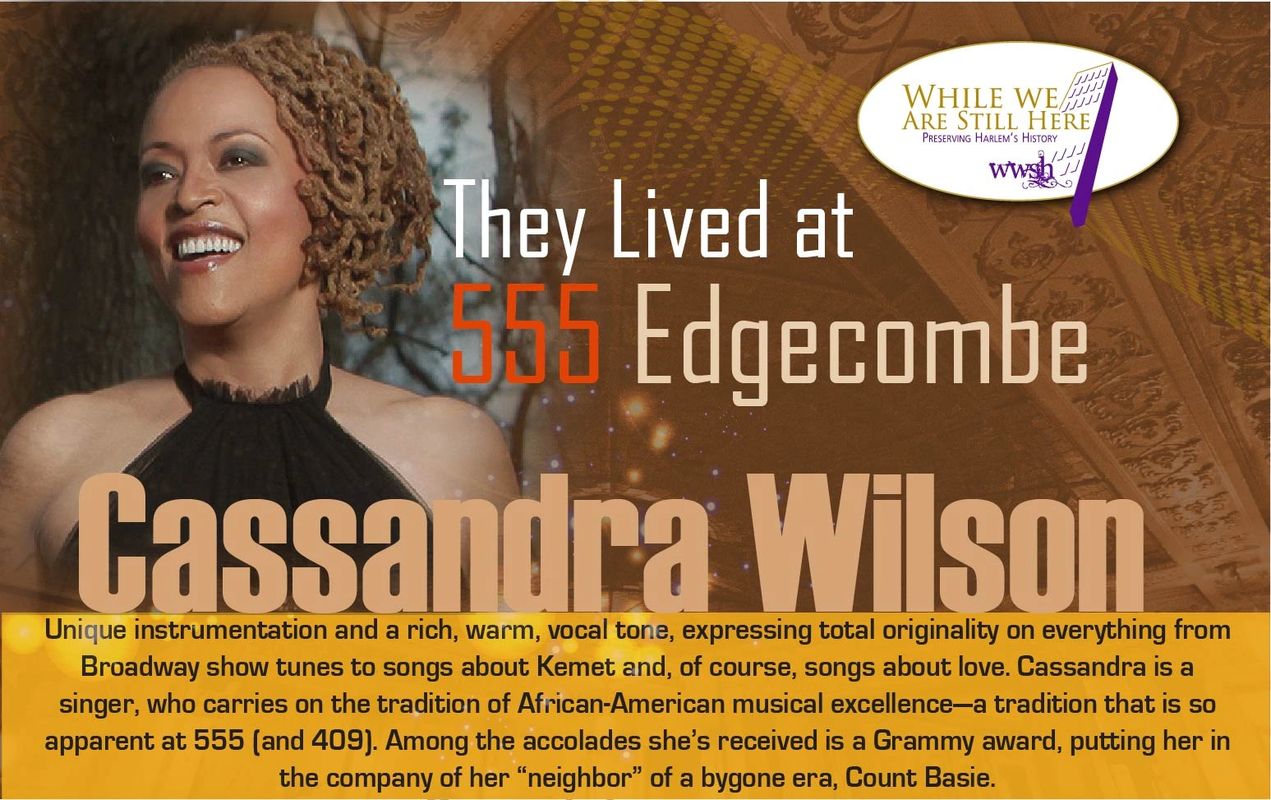
Cassandra Wilson, born in Jackson Mississippi in December of 1955, is an African American musician, vocalist, songwriter, and producer. Appraised nationally as one of the most successful female Jazz singers, Wilson was named “America's Best Singer” by Time magazine in 2001.
She has recorded more than twenty releases and has been featured by musicians such as Terence Blanchard, Bill Frisell, Charlie Haden, Angelique Kidjo, and Luther Vandross. Wilson has also been critically acclaimed for her performance in Wynton Marsalis's Pulitzer Prize-winning Blood on the Fields.
She is a two-time Grammy Award winner. Other honors include, Downbeat Female Jazz Vocalist of the Year awards (1995-96), the Miles Davis Prize by the Festival International de Jazz de Montréal (1999), the Mississippi Governor’s Award for Artistic Excellence in Music (2009), a marker on the Mississippi Blues Trail (2010), and honorary doctorates from Millsaps College, the New School, and Berklee College of Music.
Subscribe
Sign up to receive the While We Are Still Here periodic newsletter.
